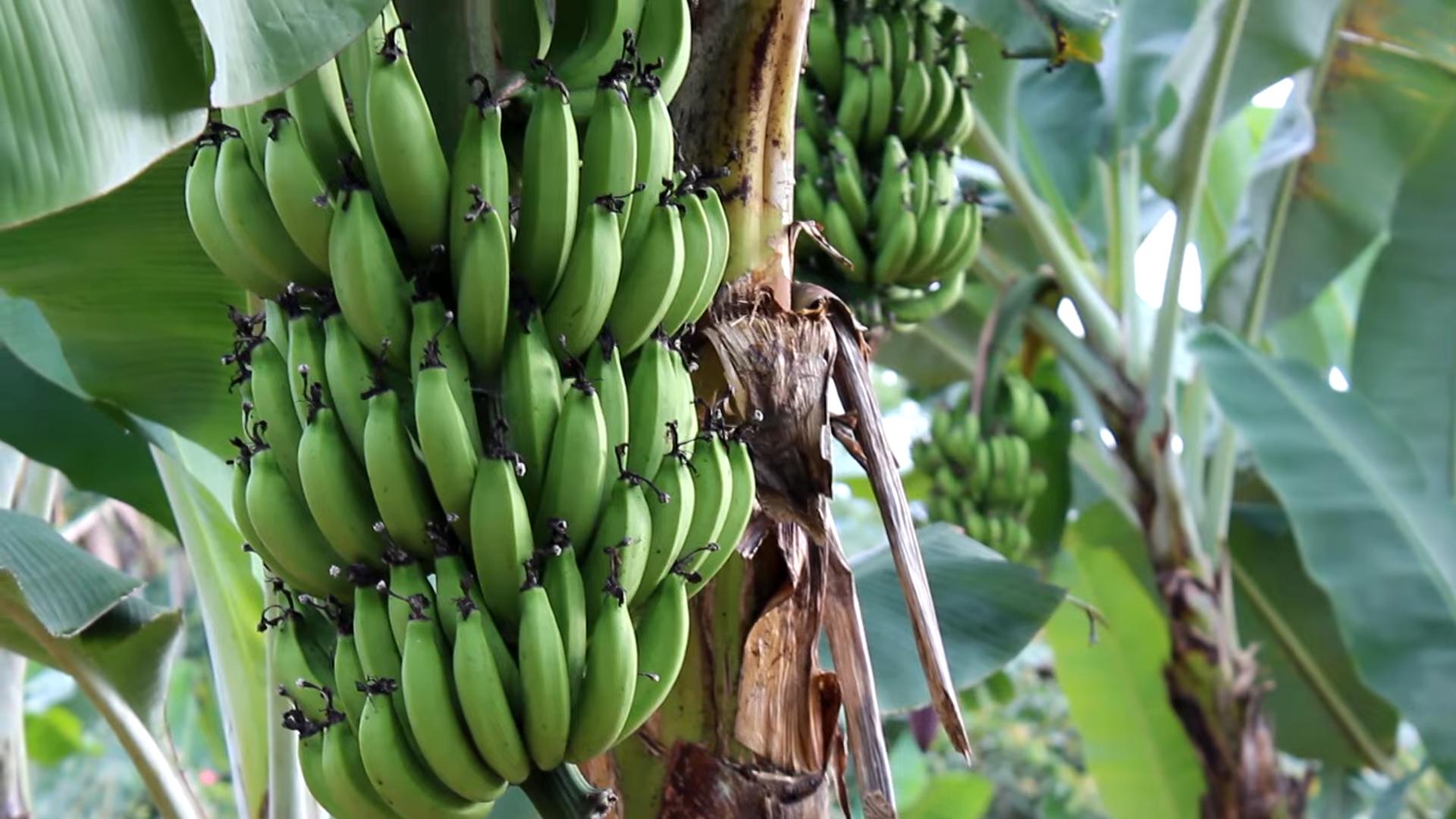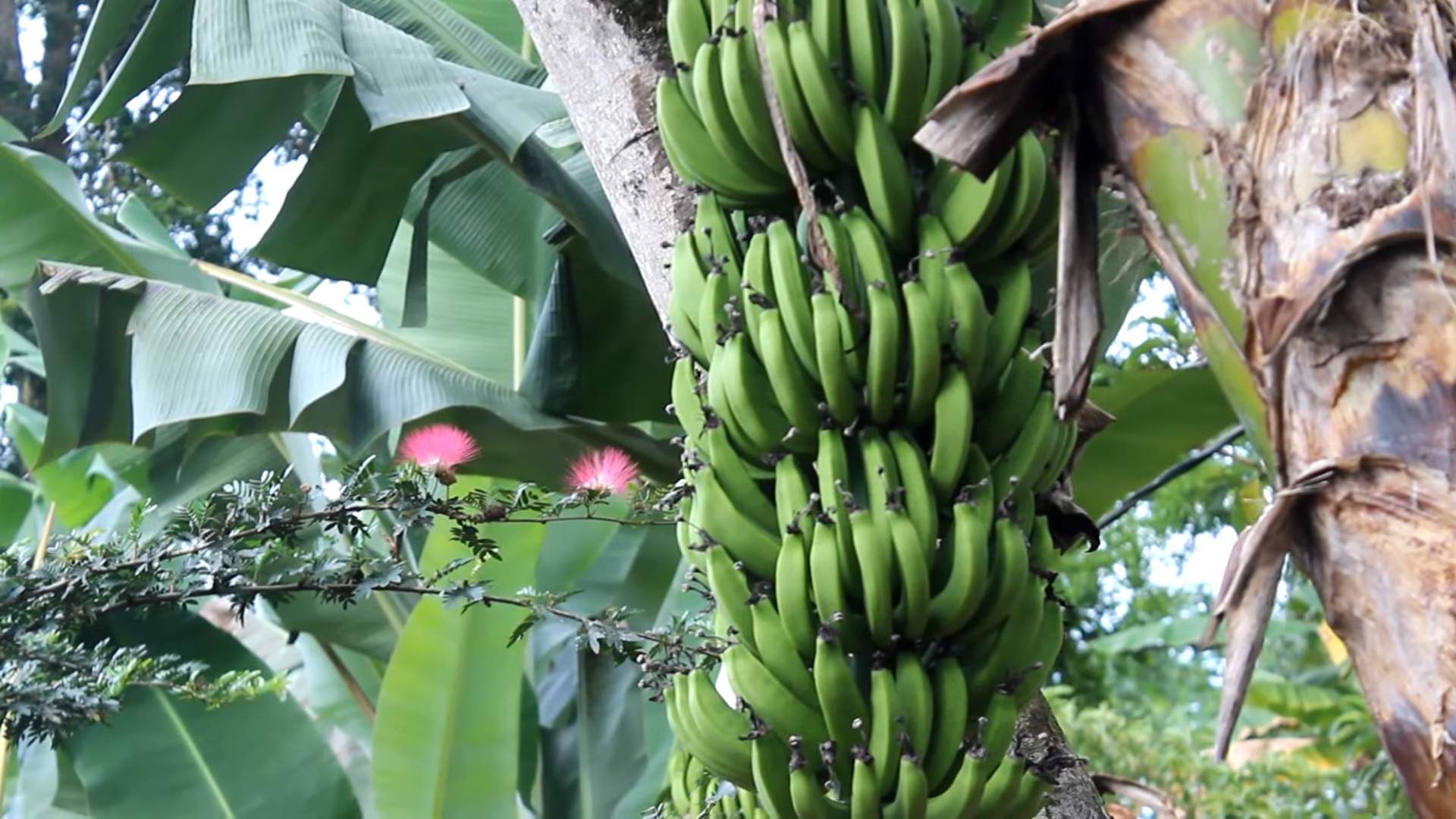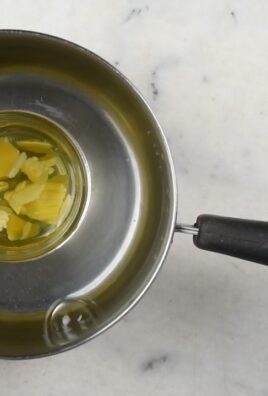Grow Bananas at Home? Absolutely! Imagine plucking a perfectly ripe, sweet banana straight from your own backyard. Sounds like a tropical dream, right? Well, it’s more attainable than you might think! For centuries, bananas have been a staple food and a symbol of tropical abundance, deeply woven into the cultures of Southeast Asia, Africa, and the Americas. From ancient medicinal uses to modern-day smoothies, the banana’s journey is as rich as its flavor.
But why should you bother trying to grow bananas at home? Because nothing beats the taste of homegrown produce, especially when it’s something as exotic as a banana! Plus, it’s a fantastic way to connect with nature, learn about plant life cycles, and impress your friends with your green thumb. Let’s face it, store-bought bananas are great, but they can’t compare to the satisfaction of nurturing your own banana plant from a small seedling to a fruit-bearing beauty.
In this article, I’m going to share some simple, yet effective DIY tricks and hacks that will help you cultivate your own banana paradise, even if you don’t live in the tropics. We’ll cover everything from choosing the right variety to providing the perfect growing conditions, so you can enjoy delicious, homegrown bananas in no time. Get ready to unleash your inner gardener and embark on this exciting banana-growing adventure with me!

Growing Bananas at Home: A Tropical Treat You Can Cultivate Yourself!
Hey there, fellow plant enthusiasts! Ever dreamed of harvesting your own bananas right in your backyard? It might sound like a tropical fantasy, but trust me, it’s totally achievable, even if you don’t live in the tropics! I’m going to walk you through everything you need to know to grow your own banana plants and hopefully, enjoy some homegrown bananas. Let’s get started!
Choosing the Right Banana Variety
First things first, not all banana varieties are created equal, especially when it comes to growing them at home. You need to consider your climate and the space you have available. Here’s a breakdown of some popular choices:
* Dwarf Cavendish: This is a super popular choice for home growers because, as the name suggests, it’s a dwarf variety. It only grows to about 6-10 feet tall, making it perfect for smaller gardens or even large containers. Plus, it produces delicious, sweet bananas.
* Grand Nain: Similar to the Cavendish, but slightly taller, reaching around 10-12 feet. It’s also a heavy producer of tasty bananas.
* Ice Cream (Blue Java): This one’s a bit more unique! The bananas have a slightly bluish tint and a vanilla-like flavor. It’s a medium-sized variety, growing to about 10-15 feet.
* Rojo (Red Dacca): If you’re looking for something visually striking, the Rojo banana is your go-to. It produces reddish-purple bananas with a slightly raspberry-like flavor. It grows to a similar size as the Grand Nain.
* Orinoco: A cold-hardy variety, relatively speaking. It can tolerate cooler temperatures better than other types, making it a good option for slightly cooler climates. The bananas are shorter and plumper than Cavendish bananas.
Important Note: Before you get too excited, check your local climate and hardiness zones to make sure the variety you choose is suitable for your area. Some varieties are more cold-tolerant than others.
Preparing the Planting Site
Okay, so you’ve chosen your banana variety. Now it’s time to get your planting site ready. Bananas are heavy feeders, so soil preparation is key!
* Sunlight: Bananas need at least 6-8 hours of direct sunlight per day. Choose a location that gets plenty of sunshine.
* Soil: They thrive in rich, well-draining soil. Amend your soil with plenty of organic matter, like compost, aged manure, or peat moss. This will improve drainage and provide essential nutrients.
* Drainage: Good drainage is crucial. Bananas don’t like to sit in soggy soil. If your soil is heavy clay, consider planting in a raised bed or amending it with sand and perlite to improve drainage.
* Wind Protection: Banana leaves are large and can be easily damaged by strong winds. Choose a location that is sheltered from strong winds, or consider planting a windbreak.
* Space: Give your banana plant plenty of room to grow. Depending on the variety, they can spread quite a bit. Check the mature size of your chosen variety and space plants accordingly.
Planting Your Banana Plant
Alright, the site is prepped, and you’re ready to get your banana plant in the ground (or container!). Here’s how:
1. Dig the Hole: Dig a hole that’s twice as wide and as deep as the root ball of your banana plant.
2. Amend the Soil: Mix some compost or aged manure into the soil you removed from the hole.
3. Plant the Banana Plant: Gently remove the banana plant from its container and loosen the roots slightly. Place the plant in the hole, making sure the top of the root ball is level with the surrounding soil.
4. Backfill the Hole: Backfill the hole with the amended soil, gently tamping it down as you go.
5. Water Thoroughly: Water the newly planted banana plant thoroughly. This will help settle the soil and get the roots off to a good start.
6. Mulch: Apply a layer of mulch around the base of the plant. This will help retain moisture, suppress weeds, and regulate soil temperature. I like to use straw or wood chips.
Caring for Your Banana Plant
Now that your banana plant is planted, it’s time to give it the TLC it needs to thrive.
* Watering: Bananas need consistent moisture, especially during the growing season. Water deeply whenever the top inch of soil feels dry. Avoid overwatering, as this can lead to root rot.
* Fertilizing: Bananas are heavy feeders and need regular fertilization to produce healthy growth and fruit. Use a balanced fertilizer (like 10-10-10) every 2-3 months during the growing season. You can also supplement with organic fertilizers like compost tea or fish emulsion.
* Pruning: Remove any dead or damaged leaves regularly. Once the banana plant has fruited, the main stem (called the pseudostem) will die back. Cut it down to the ground to make way for new shoots (called suckers) to emerge.
* Pest and Disease Control: Keep an eye out for pests like aphids, spider mites, and mealybugs. Treat infestations promptly with insecticidal soap or neem oil. Bananas can also be susceptible to fungal diseases, so ensure good air circulation and avoid overwatering.
* Cold Protection: If you live in an area with cold winters, you’ll need to protect your banana plant from frost. You can wrap the pseudostem with burlap or blankets, or even build a temporary shelter around the plant. For container-grown bananas, you can move them indoors to a bright, sunny location.
Encouraging Fruit Production
Getting your banana plant to actually produce fruit is the ultimate goal! Here are a few tips to help you along the way:
* Mature Plant: Banana plants typically take 9-15 months to produce fruit, depending on the variety and growing conditions. Be patient!
* Adequate Sunlight: Make sure your banana plant is getting enough sunlight. At least 6-8 hours of direct sunlight per day is essential for fruit production.
* Proper Fertilization: Regular fertilization with a balanced fertilizer will provide the nutrients your banana plant needs to produce fruit.
* Watering: Consistent watering is crucial, especially during the flowering and fruiting stages.
* Remove Suckers: While you want some suckers to replace the main stem after it fruits, too many suckers can compete for resources and reduce fruit production. Remove excess suckers, leaving only 1-2 to replace the main stem.
* Bagging the Fruit: Once the banana fruit starts to develop, you can bag the bunch with a large plastic bag or cheesecloth. This will protect the fruit from pests and birds.
Harvesting Your Bananas
The moment you’ve been waiting for! Harvesting your own homegrown bananas is incredibly rewarding.
1. Watch for Ripening: The bananas are ready to harvest when they are plump and the ridges on the fruit become less prominent. The color of the fruit will also change, depending on the variety.
2. Cut the Bunch: Use a sharp knife or machete to cut the entire bunch of bananas from the plant.
3. Hang to Ripen: Hang the bunch of bananas in a cool, dry place to ripen. They will ripen faster if you place them in a paper bag with an apple or banana.
4. Enjoy! Once the bananas are ripe, enjoy the fruits of your labor!
Growing Bananas in Containers
Don’t have a backyard? No problem! You can still grow bananas in containers.
* Choose a Large Container: Select a large container that’s at least 24 inches in diameter and depth.
* Use a Well-Draining Potting Mix: Use a high-quality potting mix that drains well. Avoid using garden soil, as it can become compacted in containers.
* Provide Adequate Drainage: Make sure the container has drainage holes to prevent waterlogging.
* Water and Fertilize Regularly: Container-grown bananas will need more frequent watering and fertilization than those grown in the ground.
* Move Indoors for Winter: If you live in a cold climate, move your container-grown banana plant indoors to a bright, sunny location for the winter.
Troubleshooting
Even with the best care, you might encounter some challenges along the way. Here are a few common problems and how to address them:
* Yellowing Leaves: This could be a sign of overwatering, underwatering, nutrient deficiency, or pest infestation. Check the soil moisture, fertilize regularly, and inspect for pests.
* Slow Growth: This could be due to insufficient sunlight, poor soil, or lack of fertilization. Make sure your banana plant is getting enough sunlight, amend the soil with organic matter, and fertil

Conclusion
So, there you have it! Growing bananas at home might seem like a tropical dream reserved for warmer climates, but with a little know-how and this simple DIY trick, you can absolutely cultivate your own little banana paradise, no matter where you live. We’ve walked you through the process, highlighting the key steps to success, from selecting the right variety to providing the optimal environment.
But why is this DIY trick a must-try? Beyond the sheer satisfaction of harvesting your own homegrown fruit, growing bananas at home offers a unique connection to nature. It’s a rewarding experience that allows you to witness the entire life cycle of a plant, from a small sucker to a fruit-bearing marvel. Plus, think of the bragging rights! Imagine serving up delicious, organically grown bananas to your friends and family, knowing you nurtured them from start to finish.
Furthermore, this method is incredibly adaptable. While we’ve focused on a specific approach, there’s plenty of room for experimentation. Consider trying different banana varieties to see which thrives best in your particular microclimate. Dwarf Cavendish is a popular choice for its manageable size and delicious fruit, but explore options like ‘Rajapuri’ or ‘Ice Cream’ banana for unique flavors and textures. You can also adjust the soil composition to suit your specific banana variety’s needs. Some varieties prefer slightly acidic soil, while others thrive in more neutral conditions. Don’t be afraid to experiment with different fertilizers to find the perfect balance for your plants. Organic options like compost tea and banana peel fertilizer can provide essential nutrients without the risk of chemical buildup.
Another exciting variation is to explore different container sizes. While a large container is generally recommended, you might find that a slightly smaller container works well for certain dwarf varieties, especially if you’re limited on space. Just be sure to monitor the plant’s growth and adjust watering and fertilization accordingly.
And speaking of watering, remember that consistency is key. Bananas love moisture, but they don’t like to be waterlogged. Adjust your watering schedule based on the weather and the moisture level of the soil. A simple finger test can help you determine when it’s time to water.
Ultimately, the success of your home-grown banana venture depends on your dedication and willingness to learn. Don’t be discouraged if you encounter challenges along the way. Every plant is different, and there’s always something new to discover.
We wholeheartedly encourage you to give this DIY trick a try. It’s a fun, educational, and ultimately rewarding experience that will bring a touch of the tropics to your home. And most importantly, don’t forget to share your experiences with us! We’d love to hear about your successes, challenges, and any variations you’ve tried. Share your photos and stories in the comments below, and let’s create a community of home banana growers! Let us know if this **grow bananas at home** guide helped you!
Frequently Asked Questions
Q: What is the best banana variety to grow at home?
A: The best banana variety for home growing depends largely on your climate and available space. Dwarf Cavendish is a popular choice due to its manageable size and delicious fruit. It’s also relatively cold-tolerant compared to other varieties. Other good options include ‘Rajapuri’, which is known for its sweet flavor and compact size, and ‘Ice Cream’ banana (also known as ‘Blue Java’), which has a unique flavor reminiscent of vanilla ice cream. Consider your local climate and the amount of space you have available when making your selection. Research the specific needs of each variety to ensure you can provide the optimal growing conditions.
Q: How much sunlight do banana plants need?
A: Banana plants thrive in full sun, requiring at least 6-8 hours of direct sunlight per day. Insufficient sunlight can lead to stunted growth and reduced fruit production. If you’re growing your banana plant indoors, place it near a south-facing window where it can receive ample sunlight. You may also need to supplement with artificial grow lights, especially during the winter months. If you are growing outdoors, make sure the location you choose gets plenty of sun throughout the day.
Q: What kind of soil is best for banana plants?
A: Banana plants prefer well-draining, fertile soil that is rich in organic matter. A slightly acidic to neutral pH (around 6.0-7.0) is ideal. You can improve the soil quality by amending it with compost, aged manure, or other organic materials. Avoid heavy clay soils, as they can retain too much moisture and lead to root rot. A good potting mix for container-grown bananas would consist of equal parts potting soil, peat moss, and perlite or vermiculite.
Q: How often should I water my banana plant?
A: Banana plants need consistent moisture, but they don’t like to be waterlogged. Water deeply when the top inch of soil feels dry to the touch. The frequency of watering will depend on the weather, the size of the plant, and the type of soil. During hot, dry weather, you may need to water daily. In cooler, wetter weather, you can reduce the frequency. Ensure that the pot has good drainage to prevent root rot.
Q: How often should I fertilize my banana plant?
A: Banana plants are heavy feeders and require regular fertilization to support their rapid growth and fruit production. Fertilize every 2-3 weeks during the growing season (spring and summer) with a balanced fertilizer that is high in potassium. You can also use organic fertilizers like compost tea or banana peel fertilizer. Reduce or stop fertilizing during the dormant season (fall and winter).
Q: How long does it take for a banana plant to produce fruit?
A: It typically takes 9-15 months for a banana plant to produce fruit, depending on the variety, climate, and growing conditions. After the plant flowers, it takes about 3-6 months for the bananas to mature.
Q: How do I protect my banana plant from frost?
A: Banana plants are sensitive to frost and can be damaged or killed by freezing temperatures. If you live in an area with cold winters, you’ll need to protect your banana plant from frost. If it’s in a container, you can move it indoors to a warm, sunny location. If it’s planted in the ground, you can wrap the trunk with burlap or blankets to insulate it. You can also mulch heavily around the base of the plant to protect the roots. For extreme cold, consider building a temporary structure around the plant and covering it with plastic or frost cloth.
Q: What are some common pests and diseases that affect banana plants?
A: Common pests that affect banana plants include aphids, spider mites, and nematodes. Diseases include Panama disease, black Sigatoka, and banana bunchy top virus. Regularly inspect your plant for signs of pests or diseases and take appropriate action if necessary. Use organic pest control methods whenever possible. Ensure good air circulation and drainage to prevent fungal diseases.
Q: Can I grow bananas indoors?
A: Yes, you can grow bananas indoors, especially dwarf varieties like Dwarf Cavendish. Provide plenty of sunlight, well-draining soil, and regular watering and fertilization. You may also need to increase the humidity around the plant by misting it regularly or using a humidifier.
Q: How do I harvest bananas?
A: Bananas are ready to harvest when they are plump and the ridges on the fruit become rounded. The color of the fruit will also change from green to yellow, depending on the variety. Cut the entire bunch from the plant using a sharp knife or machete. Hang the bunch in a cool, dry place to ripen. You can also separate the bananas from the bunch and ripen them individually in a paper bag.





Leave a Comment